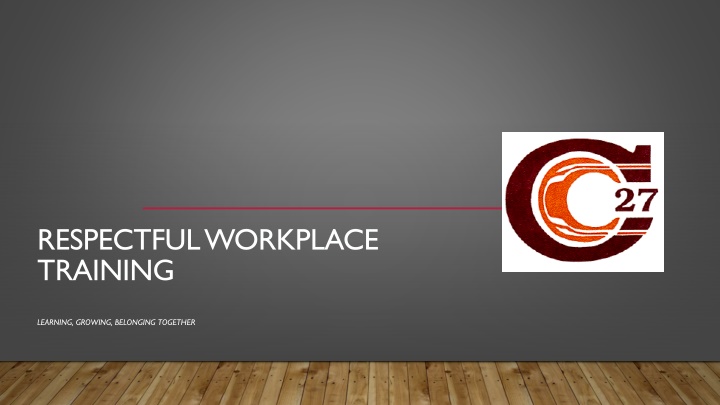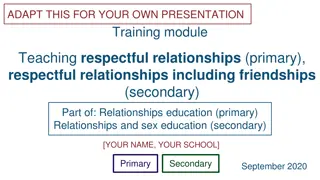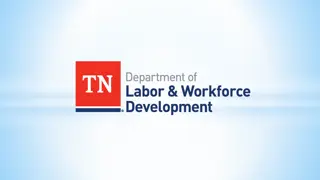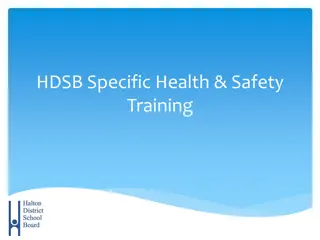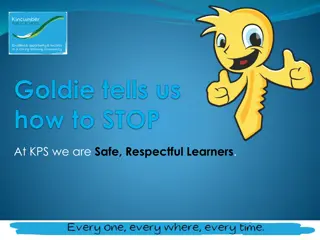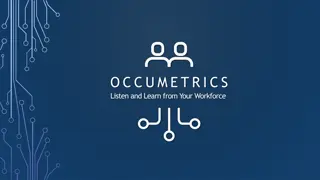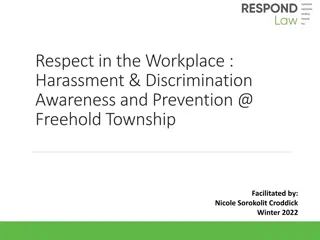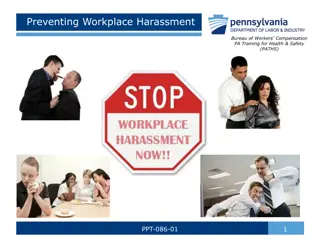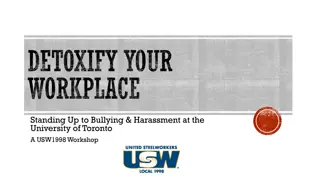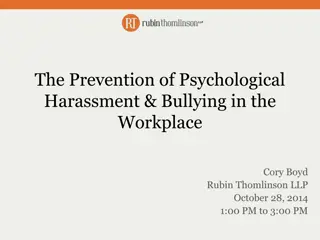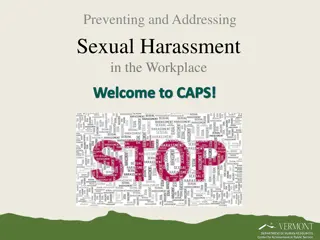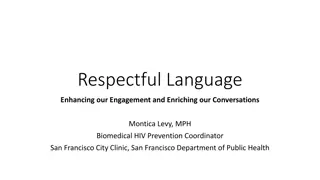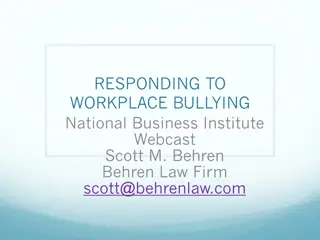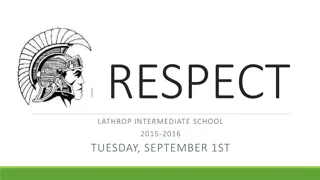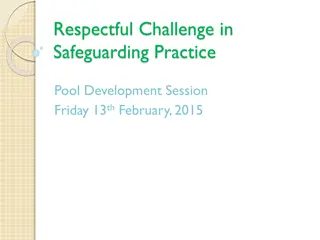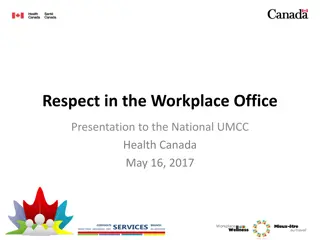Building a Respectful Workplace Training Environment
Understanding the importance of respectful workplace training is vital to foster a positive and inclusive work culture. This training aims to educate employees on recognizing and addressing bullying, harassment, discriminatory behavior, and sexual harassment. By comprehending the law, roles, responsibilities, and reporting procedures, individuals can contribute to a harmonious work environment where everyone feels valued and respected.
Download Presentation

Please find below an Image/Link to download the presentation.
The content on the website is provided AS IS for your information and personal use only. It may not be sold, licensed, or shared on other websites without obtaining consent from the author.If you encounter any issues during the download, it is possible that the publisher has removed the file from their server.
You are allowed to download the files provided on this website for personal or commercial use, subject to the condition that they are used lawfully. All files are the property of their respective owners.
The content on the website is provided AS IS for your information and personal use only. It may not be sold, licensed, or shared on other websites without obtaining consent from the author.
E N D
Presentation Transcript
RESPECTFUL WORKPLACE TRAINING LEARNING, GROWING, BELONGING TOGETHER
TRAINING OBJECTIVES To Understand: What is bullying & harassment What the law & district policy and procedures require Roles & Responsibilities Reporting procedures
WHAT IS BULLYING AND HARASSMENT? When a person takes action that they knew or reasonably ought to have known, would cause another employee to be humiliated or intimidated. The action could be any unwelcome behavior, comment or gesture, overt or subtle, that is likely to demean, humiliate, intimidate, or offend an individual There is no legitimate work-related purpose behind the action
EXAMPLES MAY INCLUDE: Cartoons or other visual displays of objects, pictures or posters that depict persons in a derogatory way Verbal or written insults, slurs, jokes about a person, personal attacks Sabotaging work/ hiding tools Spreading malicious rumours/ cyber bullying Exclusion or social isolation Purposely withholding vital information Excessive micro-managing of work
WHAT IS DISCRIMINATORY HARASSMENT OR BULLYING? The adverse treatment of an individual or group, whether intentional or not, is related to a prohibited ground of discrimination under the British Columbia Human Rights Code: Prohibited Grounds include: Indigenous identity, Race, Colour Ancestry, Place of Origin Religion, Political Belief Marital Status, Family Status Physical or mental disability Sex, Sexual Orientation, Gender Identity or Expression Age of that person or that group of class of persons Conviction of a criminal or summary conviction offence (unrelated to employment)
WHAT IS SEXUAL HARASSMENT? Any conduct, comment, gesture or contact of a sexual nature that is likely to cause offence or humiliation to an employee On reasonable grounds, it may be perceived by the employee as placing a condition of a sexual nature on employment, opportunity for training or promotion Harassment based on the prohibited ground of sex
EXAMPLES MAY INCLUDE: Making sexual comments about a person s appearance, body or clothing Sending inappropriate messages via text, email or social media Asking someone about their romantic or sexual history Making inappropriate sexual gestures, remarks or facial expressions Sharing offensive or pornographic imagery Telling lewd jokes or sharing stories about sexual experiences Making insulting comments about someone s gender identify or sexual orientation
WHO AND WHERE? Harassment can come from co-workers, supervisors, employers, external sources Can come in the form of electronic communications (text, email, social media) Can occur at the worksite or during off site interactions
WHAT IS NOT BULLYING &HARASSMENT? Expressing differences of opinion Offering constructive feedback Making a legitimate complaint about another employee s conduct Reasonable management action, including decisions about: Job duties and work to be performed Workloads and deadlines Layoffs, transfers, promotions and reorganizations Work instruction, supervision, or feedback Performance management Discipline, suspensions, terminations
HARASSMENT CAN BE UNINTENTIAL Lack of intent to harass or bully is NOT a defense. It is based on whether or not the person reasonably ought to have known that the behavior was unwelcome. I didn t know is not a defense. The perception of the person who is the subject of the unwelcome behavior is important.
RESPONSIBILITIES EMPLOYEES PRINCIPAL/SUPERVISOR Take all reasonable action to prevent where possible, or minimize bullying and harassment. Refrain from engaging in bullying and harassing behaviour Report any bullying/harassing behaviour that is observed or experienced to your supervisor or to HR. Enforce and comply with procedures. Ensure staff are trained and aware of requirements to comply. Liaise with HR to undertake and participate in investigations.
RESPONSIBILITIES DISTRICT Take all reasonable steps to prevent and where possible, minimize workplace bullying and harassment. Apply and enforce the policy and procedures Provide appropriate training to principals/supervisors and employees in respect to acceptable workplace conduct.
REPORTING AN INCIDENT Employees are encouraged to bring their complaint/concern to the attention of the person responsible for the conduct. This is often the simplest and most effective way to end the discrimination and/or bullying. When a person is not comfortable or the issue is not resolved, the employee may bring their complaint to their principal/supervisor to discuss potential means of resolving the issue.
REPORTING AN INCIDENT When the complaint can t be resolved between the two parties or if you do not feel comfortable with approaching the complainant, the next step is to file a formal complaint. A formal complaint can be filed with your principal/supervisor and can be done so verbally or in writing. If the alleged harasser is your principal/supervisor, you may contact the Director of Human Resources directly. Email is taryn.aumond@sd27.bc.ca. All complaints will be received in confidence. Employees are encouraged to keep a written record of the dates, times and nature of the behaviour.
INVESTIGATION The complaint will initially be investigated by the principal/supervisor by bringing the parties together to try to resolve the issue. If after the initial investigation, the issue is not resolved, a formal complaint will be made either verbally or in writing. Complaints will be reviewed by the Director of HR and all complaints that fall within the scope of bullying and harassment will be investigated. Human Resources will coordinate and/or conduct investigations and provide a written report with conclusions to the Secretary-Treasurer.
FOLLOW-UP Once the investigation is complete, the Director of HR or designate will meet with the complainant and respondent to review the outcome. If a complaint is found to have merit, appropriate remedial or disciplinary action will be taken. This action may include education, further training, and formal disciplinary action up to and including dismissal of the offending person(s).
CONFIDENTIALITY Complaints of discrimination or bullying and harassment involve confidential and sensitive matters. Confidentiality is required so those who may have experienced or observed discrimination or bullying and harassment will be free to come forward. All employees involved in a discrimination or bullying and harassment complaint must maintain confidentiality of any information received during the course of the investigation process. Any employee breaching confidentiality may be subject to disciplinary action, up to and including termination.
RETALIATION AND BAD FAITH COMPLAINTS Retaliation of any kind against any employee who, in good faith, files a complaint of discrimination or bullying and harassment will NOT be tolerated. Complaints of discrimination and bullying and harassment are serious matters. Employees found to have made frivolous, vexatious or malicious complaints may be subject to disciplinary action, up to and including dismissal.
ANNUAL REVIEW & TRAINING The policy and administrative procedures will be reviewed on an annual basis. All employees will be trained on the policy and procedures, including how to recognize, respond and report incidents or complaints annually.
